Mt. Lola
DESCRIPTION:
The hike to the top of Mt. Lola is a great fall hike especially this year! Late snow melt has provided wet habitat that is full of seasonal wildflowers! From the trailhead to the top of Mt. Lola is about 11.5 miles and about 3000 feet of elevation gain, but the trek is worth the 360° view of the northern Sierra Crest, Sierra Buttes and beyond!

Mt. Lola summit
 DIRECTIONS:
DIRECTIONS:
From Interstate 80 near Truckee take the hwy 89 north for about 14.5 miles until you see the green forest service sign to Independence lake and turn left on this paved road for about 1.5 mile and then continue on Forest Service Road 07-10. Follow this road over a little bridge and the Little Truckee river. Turn right and proceed on Henness Pass road (301) for abut 3.1 miles and then veer left when you see the Mt. Lola trail sign. There is a parking area, but no faciliti
UPPER MONTANE LIFE ZONE:
The hike to the top of Mt. Lola climbs through the Upper Montane zone which is typically found in the Tahoe area from lake level, 6230 ft. to 8,000 ft. The trail climbs through a mixed forest of Western White pines, Lodgepole pines and White firs as it climbs towards the mouth of Cold Stream canyon.

Upper Montaine
The trail then ascends up along Cold Steam where it crosses several seasonal streams which still in September support a number of moisture loving plants like Common Monkeyflower, Towering Larkspur and Large-Leaved Lupin. As the trail climbs up to the summit of Mt. Lola the forest floor gives way to granitic & volcanic soils. In these areas lopok for several sub-alpine plants such as spreading Phlox and Dave’s buckwheat.

flower gardens
THIS FLOWER HIKE only covers the trail to the top of Mt Lola. A few of the still blooming plants as of September 8th, 2019 are included but to experience more of a floral display, hike this in August if it has not been a huge snow year
TRY ADDING YOUR OWN OBSERVATIONS FROM THIS TRAIL TO THE TAHOE BIG FLOWER project ON iNATURALIST.

Mt. Lola Trailhead
The hike to the summit of Mt. Lola begins at the trailhead and begins as a single track trail surrounded by a mix of White Fir understory including Sierra Current, Wavy Aster and a few Crest Lupin which have finished blooming.

white fir understory

Wavy-leafed aster
The trail climbs towards cold stream Canyon and eventually follows Cold Stream through several late blooming “gardens” of Big-leaved Lupin, Corn Lilies, Soft arnica and Common Monkey Flower.

Cold Stream

late blooming floral garden
Common Name: Common Monkey Flower
Scientific Name: Erythranthe guttatus
Family: Phrymaceae
Notes: This flower has a hinged stigma which may close if the pollen received is not compatible

Common Monkey Flower

Large-Leaved Lupin
Common Name: Large-leaved Lupin
Scientific Name: Lupinus polyphyllus
Family: Fabaceae
Notes: This lupin like others has symbiotic bacteria in its root nodules which help fix nitrogen from the air into nitrates that the plant can use.

Farther up the canyon the trail intersects a 4 W drive road. Hike along this road until you come to a fork..take the left fork and the continuation of a single track trail until you reach Cold Stream meadow.
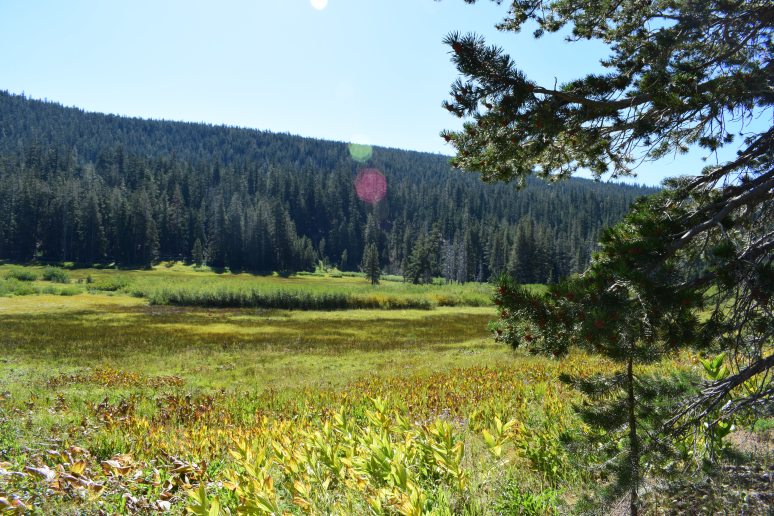
Cold Stream Meadow
The trail continues along the north end of the meadow which is full of mule ears and several herbs that have finished blooming but look for late blooming Yarrow, Coulter’s daisy, Ranger buttons and

Yarrow
Common Name: Yarrow
Scientific Name: Achillea millefolium
Family: Asteraceae
Notes: Yarrow is an astringent and will cause blood to clot by constricting blood vessels.

Coulter’s Daisy (Fleabane)
Common Name: Coulter’s Daisy (Coulter’s Fleabane)
Scientific Name: Erigeron coulteri
Family: Asteraceae
Notes: This plant will grow up to 2 feet tall!

Ranger Buttons
Common Name: Ranger buttons
Scientific Name: Angelica capitellata
Family: Apiaceae
Notes: Ranger buttons often host several different kinds of insects.
Check out the yellow faced bumble bee!
Common Name: Nettle-leaf Giant Hyssop
Scientific Name: Agasatache urticifolia
Family: Lamacieae
Notes; Check out the pinkish lavender rosy purple calyx with 4 white stamens, purple anthers and triangular leaves. The native Americans would seep leaves for tea! Also Monarch & Western tiger swallowtails feed on the leaves.

Nettle-leaved Giant Hyssop

At the far end of the meadow there is a campsite nestled in a grove of trees and beyond the campsite the route to the summit crosses Cold Stream where several moisture loving plants can still be seen blooming this late. Look for Giant Red Paintbrush, Arrow-leaved Groundsel and Mountain Blue bells which have reached the end of their blooming season.

Giant Red Paintbrush
Common Name: Giant Red paintbrush
Scientific Name: Castilleja miniata
Family: Orbanchaceae
Notes: This paintbrush like others in its family is a root parasite on various host plants.

Arrow-leaved groundsel
Common Name: Arrow-leaved Groundsel/ Butterweed
Scientific Name: Senecio triangularis
Family: Asteraceae
Notes: Check out Bombus bee feeding on the nectar of this flower.
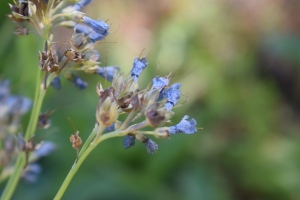
Mountain Blue Bells
Common Name: Mountain Blue Bells
Scientific Name: Mertensia ciliate
Family: Boraginaceae
Notes: Flowers hang down in panicles and are also known as “lungworts” for their use in treatment of lung diseases.
There is a campsite at the far end of meadow. Beyond the campsite the route crosses Cold Stream where several moisture loving plants can still be seen blooming such as. Look for a few Lewis Monkey flowers, Sierra Yampah and Corn Lilies still blooming!

late blooming flower garden with Corn Lilies, Big leaved lupin and groundsel

Lewis Monkeyflower
Common Name: Lewis Monkey flower
Scientific Name: Erythranthe lewisii
Family: Phrymaceae
Notes: This monkey flower has a disxerning stigma which when touched will close against the upper petals thus preventing pollination by incompatible pollen!

Sierra Yampah
Common Name: Sierra Yampah
Scientific Name: Prideridia parishii
Family: Asteraceae
Notes: This flower is also known as Sierra Queen Anne’s lace.
Common Name: Corn Lilies
Scientific Name: Veratum californicum
Family: Melanthiaceae
Notes: The leaves of this plant are toxic and should not be eaten! Native Americans used the boiled liquid from the leaves as a contraceptive.

After the trail crosses the small stream and flower garden it starts to climb and reaches a junction with a faint trail to the right…this spur leads to a small waterfall which tumbles down a slanted rock face

Once back on the main trail it will veer away from Cold stream and start a climb that will leave the white firs and start to pick up the Mountain Hemlocks and a few views of snow on the sides of the summit of Mt. Lola.

As the trail accends though the Hemlocks it looks as if the winter snows just recently melted. Look for Dave’s Knotweed, Pine lupin and a few Spreading Phlox still in bloom!

Daves Knotweed
Common Name: Dave’s knotweed
Scientific Name: Koenigia davisiae
Family: Polygonaceae
Notes: This knotweed is typically found above 7,000 ft and is often characterized by its early red/pink leaves.
Common Name: Pine Lupin
Scientific Name: Lupinus alibcaulis
Family: Fabaceae
Notes: This Lupin can be identified by its purple to white flowers and its leaflets which have 5-10 leaflets and After the flower is pollinated it turns brown!

Spreading Phlox
Common Name: Spreading Phlox
Scientific Name: Phlox diffusa
Family: Polemoniaceae
Notes: Once the phlox flower is pollinated it changes from whitish to pink/lavender.

The trail continues towards the summit of Mt. Lola. Look for a few other late blooming flowers amongst the granitic soil such as Scarlet Gilia, Mountain Pennyroyal and an occasional Fritillary butterfly on Mountain Pennyroyal.

Scarlet Gilia
Common Name: Scarlet Gilia (Skyrocket)
Scientific Name: Ipomopsis aggregata
Family: Polemoniaceae
Notes: The long flower tubes of this flower attract hummingbirds which insert their long tongues and obtain the nectar within the tubes.

Common Name: Fritillary
Family: Nymphalidae
Notes: This Fritillary is feeding on a Mountain Pennyroyal flower
As the trail winds up to the summit look for recent blooming Alpine paintbrush

Alpine Paintbrush
Common Name: Alpine Paintbrush
Scientific Name: Castilleja nana
Family: Orbanchaceae
Notes: This paintbrush has very hairy leaves and like other paintbrushes is a hemiparasite on the roots of nearby plants.
A the trail reaches the summit spectacular 360 views await the hiker!

view towards Castle Peak

view towards Independence Lake & Stampede reservoir

view towards Sierra Buttes
All photographs were taken by Lynn Hori. Plant information was gathered from: Plants of the Tahoe Basin by Michael Graft, Tahoe’s Spectacular Wildflower trails by Julie S. Carville, the Jepson Manual 2012 and The Laws field guide to the Sierra Nevada by John Muir Laws. Trail information was gathered from Afoot & A field Reno Tahoe by Mike White.
Rock Creek/Little Lakes Valley

Trail description: The Rock Creek/Little lakes Valley is a classic glacier carved valley situated at about 10,000 feet in elevation. Surrounded by the John Muir Wilderness with views of 13,000 foot peaks from anywhere in the canyon, this area offers a unique glimpse into the Eastern Sierra bioregions (Jepson SNH & SNE) where the Great Basin floristic region meets the Sierra Nevada. The best time to see and hike this area is Late May until September (except 2017 where many of the trails still had snow patches and lots of water.)

Inyo Beardstongue
Flowers featured:
Hiking along the Little Lakes Valley trail, Ruby lake and Mono pass trails feature some endemic alpine plants adapted to survive in the higher elevations of the Rock creek area (9,000 ft -10,000ft.) Plants such as Inyo Beardstongue, Penstemon papillatus and Inyo tonestus, Tonestus piersonii , Alpine Coloumbine, and Quillworts may also be seen.

Inyo Tonestus
2018 update:
August is still a great time to visit Little Lakes Valley. Beautiful floral display still adorn the trail and lake areas.
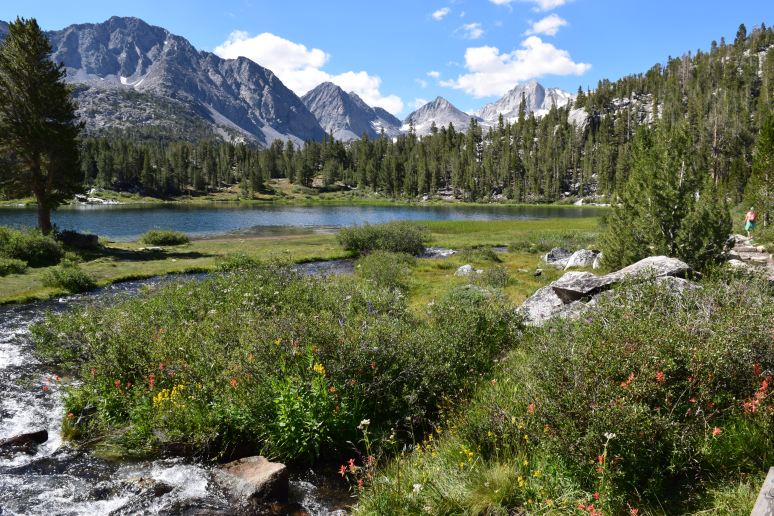
Look for White columbine (Aquiligia pubescens) amongst Subalpine Larkspur ( Delphinium polycladon) as well as an occasional Sierra Gentian (Gentianopsis holopetala).

White Columbine & Sierra Larkspur

Alpine Genetian
Take the Mono Pass trail and enjoy the great views back to Marsh, Heart and box lakes. Climb up to Ruby Lake and go for a swim before heading up to Morgan Pass
Ruby Lake View Marsh, Heart & Box lakes
 Directions:
Directions:
Rock Creek/Little Lakes Valley is 31 miles south of Mammoth lakes off of Hwy 395 and about 8.5 miles west from Tom’s Place on Rock Creek Road.
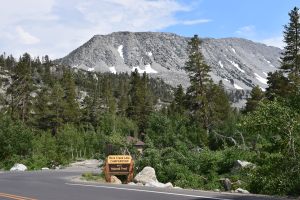
Rock Creek Lake campground
Accomodations:
The Rock Creek canyon area offers 8 National forest campground opportunities. The Rock Creek campground is located next to Rock Creek Lake and is the closest to the Mosquito Flat trail head. The Rock creek resort has cabins that can be rented during the summer season. (http://www.rockcreeklakesresort.com/4)

Rock creek Lakes Resort

Sub Alpine
Sub-Alpine and Alpine Life Zones:
The hike along the Little Lakes Valley and Ruby Lakes trail are in a region above 10,000 feet characterized by Lodgepole and Whitebark pines or the Alpine regions above tree line. The native plants/trees are well adapted to survive these higher elevations where winters can provide 30-40 inches of precipitation mostly in the form of snow. These plants are almost all perennial with adaptations that include deep taproots and small reflective, light colored leaves. Many of these use some form of vegetative reproduction to enable them to reproduce in a very limited growing season.
THE FLOWERS FEATURED IN THIS TRAIL BLOG ARE ORGANIZED BY THEIR OCCURANCE ALONG THE TRAIL THROUGH THE DIFFERENT BIOTIC ZONES. (All plants listed were seen between in August 2016 & July 2017.)
TRY ADDING YOUR OWN OBSERVATIONS FROM THIS TRAIL TO THE Flora and Fauna of Hikes in Lake Tahoe project ON iNATURALIST.

Mosquito Flat Trail head: This trail head is one of the highest in the Sierras at about 10,200 feet in elevation. The Lakes Valley trail meanders along Rock Creek and skirts around Mack, Marsh, Heart, Box, Long and Chicken Foot lakes which is an easy climb with gorgeous views of the many 13,000ft peak. The trail continues its climb and eventually reaches Morgan Pass at about 11.000 ft. The hike from the trail head to Morgan pass is about 8 miles round trip

Morgan Pass

Mt. Morgan

John Muir Wilderness:
The trail enters the John Muir Wilderness a few 100 yards pass the Mosquito Trailhead sign.
The Exposed granitic soil along the trail into the John Muir Wilderness is dotted with plants adapted to long sun exposure and dry soils such as the Nuttall’s Phlox, Prickly phlox, Singlehead Goldenbush, Sulfur Buckwheat and an occasional Wax Current

Sulfur Buckwheat

Nuttall’s Phlox

Singlehead Goldenbush
Common Name: Singlehead Goldenbush
Scientific Name: Ericameria suffruticosa
Family: Asteraceae
Notes: This Aster has ray heads only and is characterized by undulating leaves and petals that are seem to be in disarray. It is grows sporadically on dry granitic slopes.

Wax Current

Prickly Phlox
Common Name: Prickly phlox (Granite Phlox)


Applegate’s Paintbrush
Common Name: Applegate’s Paintbrush
Scientific Name: Castilleja applegatei
Family: Orbanchaceae
Notes: This plant like other paintbrushes is a root parasite on neighboring plants. It can be identified from other reddish paintbrushes by its wavy leaves

Squirrel tail grass
Common Name: Squirrel tail grass
Scientific Name: Elymus elymoides
Family:P oaceae
Notes: This grass is related to other California bunch grasses. Notice that the flowers branch from a clump of stems.

Sierra Soda Straw
Notes: This plant is usually found in gravely slopes. It is a great entomologist plant because the large flower heads attract lots of bugs and beetles!
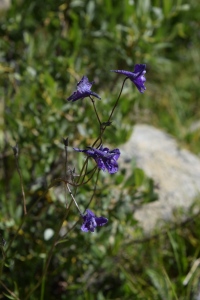
Nuttall’s Larkspur
 After Crankcase grade the trail levels out for a while and in this open sub-alpine terrain look for Little Elephant heads, a few Anderson’s Asters and a distinguished looking Mt. Timonthy in the grass family.
After Crankcase grade the trail levels out for a while and in this open sub-alpine terrain look for Little Elephant heads, a few Anderson’s Asters and a distinguished looking Mt. Timonthy in the grass family.

Little Elephant’s Head
The Common Name: Little Elephant Heads

Anderson’s Aster

Mountain Timothy

As the trail ascends towards the junction for Morgan/Mono pass a few moist areas left over from the late snow melt provide the moist habitat needed for the Giant Red Paintbrush and Swamp onion with its characteristic onion odor along with several Willows, the Sierra Willow and the Red/Mono willow (Sierra yellow stem, Red stems), Alaska Rush and Lushy Lupin.

Giant Red Paintbrush


Alaskan Rush

Lushy Lupin
 Check out the cool caterpiller along the trail!
Check out the cool caterpiller along the trail!
The trail then comes to a junction, the left fork continues along the Lakes Valley trail to Morgan Pass and the right leads up to Ruby lake and Mono pass. (In some years like 2017, the trails may still have quite a bit of swow!)

Trail to Morgan pass levels off to give great views of the Lakes valley 13,000 + peaks.
From “Crankcase grade”. This blog is first going to follow the left junction to Mack, Marsh, Box and Long lakes

Sierra Juniper
Look for the first siting of a Sierra Juniper (some of the oldest in the Sierras, up to 10,00ft) mixed in amongst the Lodgepole pines

Lodgepole Pine
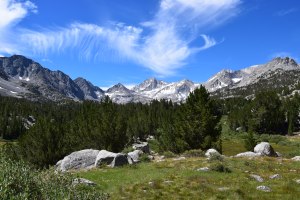
As the trail climbs up Little Lakes Valley more views of the 13,000 foot peaks come into view. From left to right: Mt. Morgan, Rosy Finch Peak, Pyramid peak, Bear Spire, Mt Dade, Mt Abbot

The trail passes through several moist areas which support sub-alpine plants that require more water such as Shooting stars (fields of them in 2017) and many Few Flowered Meadow Rues and a few Stellaria dotted in between the Alpine Gentian.

Alpine Shooting Stars

Few Flowered Meadow Rue

Stellaria
Scientific Name: Stellaria longipines
Family: Caryophyllaceae
Notes: These plants are often found in moist marshy areas.

Alpine Genetian
Scientific Name: Genetiana newberryi
Family: Gentianaceae
Notes: Check out the flower of the Genetian with its long tubular throat marked with green dots and green nectar lines. These flowers will close when it rains.
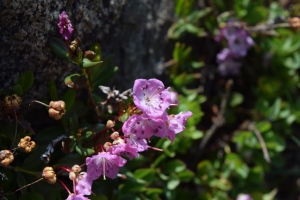
Kalmia
Up the trail before Marsh Lake there are some large patches of Kalmia (Alpine Laurel) which are still blooming in July 2107 as a late snow melt resulted in later blooming .

Marsh Lake 7.2017
The trail then reaches the east end of Marsh Lake. Look along the moist areas near the lake for plants that depend on this wetter environment like, Slender cinquefoil and Primrose Monkeyflower.

Slender Cinquefoil

Primrose Monkeyflower

Marsh Lake 7. 2016
Later in the season (or a dryer year like 2017) the edges of Marsh Lake dry out and support Rosy Pussy Toes and Alpine Golden rod, Sierra Whorled Penstemon as well as Dwarf Billberry which is related to Blueberries

Common Name: Rosy Everlasting
Scientific Name: Antennaria rosea
Family: Asteraceae
Notes: This plant is a member of the aster family but is missing ray flowers. The ray flowers are covered with bracts so that the heads are small and inconspicuous. These plants tend to form mats among grasses and sedges. Anntenaria are related to the swiss Edelweiss

Alpine Golden Rod & Sierra Whorled Penstemon
Common Name: Alpine Golden rod
Scientific Name: Solidago multiradiata
Family: Asteraceae
Notes: Several of the Paiute Indians use this plant in solution to treat cuts, sores and burns.
Common Name: Sierra Whorled Penstemon
Scientific Name: Penstemon heterodoxus var heteroduoxus
Family: Plantanginaceae
Notes: This penstemon is a high elevation species (9,000ft) and is the only penstemon with blue flowers arranged in whorls. These clusters are sticky and glandular.

Showy Sedge
Along the edge of Marsh Lake there are large patches of sedges including Showy Sedge
Common Name: Showy Sedge
Scientific Name: Carex spectabilis
Family: Cyperaceae
Notes:This sedge is definitely the most abundant one in the Rock Creek area. It is particularly noticiable due to the terminal male anthers bursting with pollen.
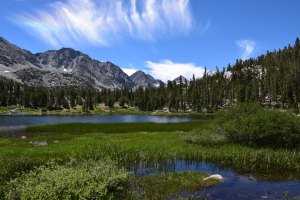
Heart Lake
As the trail leads to Heart Lake look for Monks Hood with its characteristic folded petalsOn the west side of Heart lake check out the Western Rosewort, a member of the Stonecrop family and a few Mt.Spirea along the trail.

Monks Hood

Western Rosewort

Mt Spiraea

As the trail ascends towards Box lake check out the afternoon skies!

Box Lake

vernal pool
On the right side of the trail look for a Vernal pool which provides the prefect habitat for another
FEATURED FLOWER: Quillworts
Vernal pools offer a good habitat for the Yosemite Toad to lay its eggs…check out all the tadpoles of the Yosemite Frog!
Look in the drying mud puddles around the vernal pool for butterflies such as the Coppers and Painted Ladies which often seek out these areas for salt deposits

Copper butterflies

Also look for native bees such as this Megachile bee feeding in the dried mud of this vernal pool

hiking to Longs Lake
As the trail continues to climb towards Long Lake look along a granitic talus slope look for Fireweed which often blooms later in the summer and Leitchlin’s Mariposa Lily sticking up between Cream bush amongst the granite rocks

Fireweed
Common Name: Fireweed
Scientific Name: Chamerion angustifolium
Family: Onagraceae
Notes: This plant often grows in disturbed areas and is a favorite of Rufus Hummingbirds.

Leitchlin’s Mariposa Lily
Common Name: Leitchlin’s Mariposa Lily
Scientific Name: Calochortus leitchtlinii
Family: Liliaceae
Notes: These plants collect moisture and store it is their deep root system and therefore can grow in dryish granitic slopes in between other plants such as Cream bush

Cream bush
ommon Name: Cream bush
Scientific Name: Holodiscus discolor
Family: Rosace
Notes: The leaves of this plant are distinct in the way they have serrated edges with prominant views.

FEATURED FLOWER: hiking from Box to Long lake look for Alpine Columbine nestled amongst the granite talus slopes
Common Name: Alpine Columbine
Scientific Name: Aquilegia pubescent
Family: Ranuncularaceae
Notes: This columbine shares its habitat with the Pika which will dry leaves and flowers from this plant to eat in the winter
As the trail climbs up to Long lake there are usually several creek crossings. In July 22, 2016 the crossing Rock Creek was definitely doable, but in July , 2017 (photo on right) it was rather a challenge.
Growing out of the Talus slopes surrounding the south side of Long Lake look for an occasional Alpine Speedwell recognized by their purplish/lavender colored petals. Mixed alongside of the Speedwells might be some Alpine Catchfly with their glabrous hairs and nestled amongst these flowers might also be Carpet clover and an occasional Sibbaldia

Long Lake

Alpine Speedwell
Common Name: Alpine Speedwell
Scientific Name: Veronica wormskjolii
Family: Plantaginaceae
Notes: This colorful plant is often found under Sierra Willow and unlike others of its family it only has 2 stamens and barely an irregularity in its petals.

Alpine Catchfly
Common Name: Alpine Catchfly
Scientific Name: Silene sargentii
Family; Caryophllaceae
Notes: The name “catchfly” refers to the sticky glandular secretions which probably do not catch a lot of flies but many grains of sand! The inflated calyx is a characteristic of many plants in this family.

Carpet clover
Common Name: Carpet clover
Scientific Name: Trifolium monanthum
Family: Fabaceae
Notes: This member of the pea family has root nodules which carry a symbiotic bacteria, rhizobia which fixes nitrogen and helps this plant survive in nitrogen poor soils
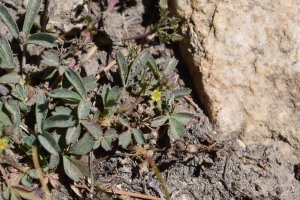
Sibbaldia
Common Name: Sibbaldia
Scientific Name: Sibbaldia procumbens
Family: Asteraceae
Notes: This plant is ground hugging and charactrized by 5 bracelets between the sepals and small petals with only 5 stamen.

Long Lake
As the trail continues around the west end of Long lake many more plants can be found that love the moist snow melt edges of the lake especially members of the Ericaceae family, Mt. Heather and Labrador Tea.

Mt. Heather
Common Name: Mt. Heather
Scientific Name: Phyllodoce breweri
Family: Ericaceae
Notes: These heather like others in their family have a mutualistic relationship with mycorrihizal bacteria in the soil that help it to absorb essential nutrients from the soils in which it grows.

Labrador Tea
Common Name: Labrador Tea
Scientific Name: Rhododendron columbian
Family: Ericaceae
Nos: The name is misleading since the leaves smell like turpentine!

Toad Lily
Along the moist areas at the west end also Look for Toad Flax which is in its own family: Tofieldaceae
Common Name: Toad Flax
Scientific Name: Triantha occidentals
Family: Tofieldiacea
Notes: This plant is not in the lily family but has been moved to its own family.

Tonestus piersonii
FEATURED flower: Check out the tucked up in the crevices of the talus rocks along the trail look for the endemic Inyo Tonestus (Cushion plants)
Common Name: Inyo Tonestus
Scientific Name: Tonestus piersonii
Family: Asteraceae
Notes:The place where this California endemic was first described is the Upper Rock Creek Lake basin and it maybe actually seen where it was originally found! It is characterized by leaves which are toothed and round daisy like heads with short yellow rays.
In the granitic soils along the trail is also a good habitat for Mt. Sorrel and Oval-leaved Buckwheat.
Common Name: Mt. Sorrel
Scientific Name: Oxyria digyna
Family: Polygonaceae
Notes: Mt. Sorrel is considered an “indicator plant” for the Alpine Zone (elevation is around 9,000-10,000 ft) and refers to the region above timberline. Look for this plant’s kidney shaped leaves and reddish clusters of tiny flowers. Check out the taste of the leaves which can be used to fulfill ones thirst on a hot day!

Mt Sorrel

Oval-Leaved buckwheat
Common Name: Oval-leaved Buckwheat
Scientific Name: Erigonum ovalifolium
Family: Polygonacea
Notes: This buckwheat is a typical alpine “cushion plant” with its pale color, dense hairy leaves and long tab root.

Long Lake
At the west end of Long Lake in the moist meadow area near the shore is another

Piersen’s Paintbrush
FEATURED FLOWER:
Common Name: Piersens Paintbrush
Scientific Name: Castilleja peirsonii
Family: Orobanchaceae
Notes: This paintbrush like others in its family is a root parasite on nearby plants,

Clubmoss Ivesia
Also look for Clubmoss Ivesia and another cool Paintbrush, Castilleja lemmonii as well more showy Sedge
Common Name: Clubmoss Ivesia
Scientific Name: Ivesia lycopodioides
Family: Rosaceae
Notes: This member of the rose family has small leaves that are often mistaken for fern leaves and is sometimes referred to as “Mousetails”.

Lemmon’s Paintbrush
Common Name: Lemmon’s Paintbrush
Scientific Name: Castilleja lemmonii
Family: Orobanchaceae
Notes: This paintbrush is often found along with Piersens Paintbrush.

Morgan Pass
The trail continues up towards Chickenfoot lake and eventually Morgan pass and Gem Lake which is one of the passes leading to more of the John Muir Wilderness.

Trail split to Mono Pass
TRAIL TO RUBY LAKE AND MONO PASS:
About .5 miles from the beginning of the Mesquite Trail head is the turn off to Ruby lake and Mono pass. The hike to Ruby is about 2 + miles from the trail split. The round trip hike to Mono Pass is about 8 miles.

Trail to Mono Pass
The trail ascends up from the Little Lakes Valley towards Mono pass. More sub-alpine plants dot the trail side preferring these dry granitic soils.
Common Dandelion dot the beginning parts of this trail, although it is not native, it does provide habitat for this Bee Fly. Also scattered along the trail is Sierra Wallflower, which seems to prefer these open granitic soils.

Bee Fly on Common Dandelion
Common Name: Bee Fly
Scientific Name: Bombyliidae
Order: Diptera

Sierra Wallflower
Common Name: Sierra Wallflower
Scientific Name: Erysimum perenne
Family: Brassicaceae
Notes: This plant is often an early bloomer in the rocky sandy soil along the trail.

Kalima
The trail climbs through seeps that have recently melted providing great habitat for more early blooming Mt Heather (check out the exerted stamen and pistil) and patches of Alpine Laurel, Kalima.

Mt. Heather


Kalima
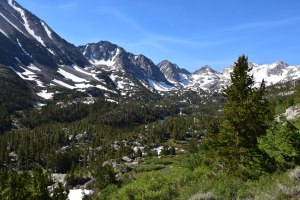
Little Lakes Valley
As the trail climbs upwards towards Mono pass, great views of Little Lakes Valley can be seen (Mt Morgan) and the 13,000 feet peaks of the Sierra Crest (and Mack Lake)
Along the trail look for Mt.Snowberry and a few Wild Oats scattered along the way

Mt. Snowberry
Common Name: Mt. Snowberry
Scientific Name: Symphoricarpos rotundifolius
Family: Caprifoliaceae
Notes: Cassin’s finches relish the bitter whitish berries that appear towards the end of the summer.

Mt. Wild Oats
Common Name: Mountain Wild Oats
Scientific Name: Danthonia intermedia
Family: Poaceae
Notes: The short growing season of the higher elevation Little Lakes valley keeps out many of the non-native lower elevation species so most of the grasses you see are natives such as Mt Wild Oats.
Early in the season ( July 11, 2017 ) the trail may be a small creek and covered with snow!
This trail may not offer the diversity of flowers that the Little Lakes Valley trail does but it does give great views of the Box and Heart lakes.

The trail up to Ruby lake (July 2017) was still covered in snow and a rushing Ruby creek provided extra challenges to the hike
Ruby Lake was still covered with ice and the surrounding shore line, not yet able to support many flowering plants except for a few Alpine Laurel (Kalima)

Ruby Lake 7.17

Ruby Creek

Alpine Laurel
The trail continues to Mono Pass and another entrance into the John Muir Wilderness (the pass was closed due to snow in middle July 2017)
HILTON LAKES TRAILHEAD
The trail all the way to Hilton Lakes is about 10 miles round trip. The trailhead can be accessed about a 1/3 of a mile from Rock Creek lake.


View south lower lakes valley
The trail climbs quickly up to a forested bench offering a view across the southern rock creek area. The more south facing slopes of this trail support a variety of chaparral type vegetation which are more adapted to drier conditions.
Look for plants adapted to this drier environment and granitic soil such as Silver Lupin, Squirrel tail grass, Curl-leaved Mt Mahagony, Sulfur Buckwheat and Scarlet gilia. These plants are characteristic by reduced leaves and shorter growing seasons

trail to Hilton Lakes

Silver Lupin
Common Name: Silver Lupin
Scientific Name: Lupinus argenteus
Family: Fabaceae
Notes: Note the silvery leaves and dull blue flowers.
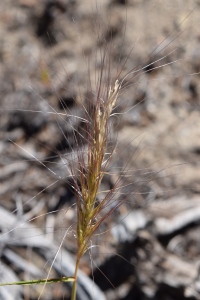
Squirreltail grass
Common Name: Squirrel Tail grass
Scientific Name: Elymus elymoides
Family: Poaceae
Notes: This grass is characterized by seed-containers that bear awnes 5-15 inches long

Curl-leaved Mahagony
Common Name: Curl-leaved Mahagony
Scientific Name: Cercocarpus ledifolius
Family: Rosaceae
Notes: This plant is characteristically an Eastern side of the Sierras plant. the small flower lacks petals but produces showy displays of its feathery fruit.

Sulfur Buckwheat
Common Name: Sulfur Buckwheat
Scientific Name: Eroigonum umbellatum
Family: Polygonaceae
Notes: The flowers of this plant turn from yellow to a burnt orange as the summer progresses.

Scarlet Gilia
Common Name: Scarlet Gilia (Skyrocket)
Scientific Name: Ipopomsis aggregata
Family: Polemoniaceae
Notes: The red color of this plant’s flower attracts hummingbirds.
Growing amongst the Scarlet gilia and Silver Lupin is another
FEATRUED FLOWER: Pine Genetian

Common Name: Pine Genetian
Scientific Name: Fraser’s puberlenta
Family: Gentianaceae

Trail to Hilton lake
The trail leads up to a heavely forested area and skirts a creek and provides a moist habitat for moisture loving plants like Coulter’s Daisy, Alpine Lily, Arrow-leaved groundsel and Corn lily

Coulter’s Daisy
Common Name: Coulter’s Daisy
Scientific Name: Erigeron coulteri
Family: Asteraceae
Notes: Coulter’s daisy is characterized by its pure white color and intricate multi-rayed ray flowers.

Alpine Lily
Common Name: Alpine Lily
Scientific Name: Lilium parvum
Family: Liliaceae

Arrow-leaved groundsel
Common Name: Arrow-leaved groundsel
Scientific Name: Senecio triangularis
Family: Asteraceae
Notes: This groundsel is often found along side stream beds and is characterized by it s large triangular leaves. It is also known as Butterweed.
Common Name: Corn Lily
Scientific Name: Veratum californicum
Family: Melanthiaceae
Notes: This plant is also known as False Hellebore. The leaves actually form the stalk.
Continuing along the creek trail look for other shade/moister dependent plants such as Sidebells and a patch of basidio fungus

Sidebells
Common Name: Sidebells
Scientific Name: Orthilia seconda
Family: Ericaceae
Notes: This plant is related to the wintergreens and is also known as one-sided wintergreen because the flower cluster only grows on one side.

After about a mile + the trail intersects at a junction to Hilton Lakes or back to Rock creek. (On this hike we looped back to Rock Creek)

The climb back down gives good views across the lower valley. The trail decends through habitat that has a southern exposure and is made up mostly of dry granitic type soils.
Look for other examples of the oldest trees on the Eastern Side, Sierra Juniper.
Common Name: Sierra Juniper
Scientific Name: Juniperus occidentalis
Family: Cupressaceae
Notes: Sierra Juniper are some of the oldest plants in the Sierras with many trees over 1,000 years old.
In the habitat around the Sierra Juniper also look for Hoary Aster and Stephanomeria

Hoary Aster
Common Name: Hoary Aster
Scientific Name: Dieteria canescens
Family: Asteraceae
Notes: This aster is often found around Great Basin Sagebrush and Sulfur buckwheat. It is different than other daisy like flowers because each flower is surrounded by rows of pointed green bracts and it has pointed lobed leaves

Stephanomeria
Common Name: Stephanomeria
Scientific Name: Stephanomeria tenuifolia
Family: Asteraceae
FEATURED FLOWER: Further down the trail, keep your eyes out for Inyo Beardstongue

Inyo Beardstongue
Common Name: Inyo Beardstongue
Scientific Name: Penstemon papillatus
Family: Plantanginaceae
Notes: This penstemon is found on this eastern side of the sierras in this open granite lodge-pole pine habitat.
The trail continues back to Rock Creek Resort and lake.
All photographs were taken by Lynn Hori. Plant information was gathered from: Plants of the Tahoe Basin by Michael Graft, Rock Creek Wildflowers by Cathy Rose, the Jepson Manual 2012. Trail information was gathered from Trails of the Rock Creek Canyon area published by Rock Creek Lakes resort.
BAYVIEW TRAIL to AZURE & DICK’S LAKE

Granite Lake

Azure Lake
Trail description: The trail to Granite, Azure and Dick’s Lakes begins at Bayview Trail head which is one of the starting points for hikes into the Desolation Wilderness. This trailhead will also continue on to Upper, Middle and Lower Velma lakes as well as many other spectacular cirque lakes and alpine granitic landscape along this trail head. This trailhead is very popular with backpackers hiking into some of the most picturesque areas in the Sierras. The hike to Granite Lake is about 1 mile from the trailhead while Azure Lake is a little under 4 miles from the trailhead and Dick’s Lake about 5 miles.

Dick’s Lake
DIRECTIONS:
The Bay view trailhead is off Highway 89 just as the road loops around Emerald bay. From Tahoe city it is about 19 ½ miles and about 7 ½ from the junction of Highway 50 and 89. There is not much parking at this trailhead so make sure to start early!

Donner Pass/Sugar Bowl to Squaw Valley
The hike from Donner Pass/Sugar bowl to Squaw valley is a 15-16 mile trek across the crest of the Donner range and follows the Pacific Crest Trail with outstanding views of the North Folk of the American river canyon, Coldstream Valley and Cedar Creek Canyon. The PCT passes by Mt. Judah and Mt. Lincoln of the Sugar Bowl ski area and Anderson Peak and Tinker’s knob as it winds south. At about 8.4 miles the trail junction to the Granite Chief trial and heads east from the PCT. There is an option to break up the hike and backpack into the Benson Hut. (more info to follow.)
UPPER MONTANE ZONE: The first part of the hike ascends through the Upper Montane zone which is typically found in the Tahoe area from lake level, 6230 ft. to 8,000 ft. The average summer temperature is between 73°-85°F and the winter between 16°-26°F . This zone usually receives between 35-65 inches of snow and provides well drained soil for a variety of flora.
UPDATE 8.16
August is still a great time to head out on the Pacific Crest Trail along Donner crest whether it be all way to Squaw Valley or an “out and back’ to Sierra Club’s Benson’s Hut ( 10 + miles round trip) or to Tinker’s knob (12+ miles round trip).
This is a great time to enjoy the buckwheats especially Lobb’s Buckwheat, Eriogonum lobii and Alpine Knotweed, Aconogonon phytoalacifolium and Brewer’s Aster, Eucephalus breweri.

Brewer’s Aster

Alpine Knotweed
Lobb’s Buckwheat can often be found in outcroppings of granitic soil beginning about mid to even higher elevations. The whitish-yellow flowers change to deeper reddish colors the summer progresses. Why the change in color?
One hypothesis is that the reddish color may act to help cool the plant down so that more of its energy can be directed towards seed production.

Lobb’s Buckwheat

Lobb’s Buckwheat flowers
Mt. Rose
UPDATE: JULY 2023
A great way to experience the beauty of the Mt. Rose upper montane area is to take the 1.3 mile interpretive loop trail in Tahoe Meadows. Across the street from the parking lot of the Mt. Rose trailhead is the entrance to the Tahoe Meadow parking lot.


 Silver lupin (Lupinus argenteus)
Silver lupin (Lupinus argenteus)

DOG’S are allowed:
This is a great hike to do with dogs since there is Galena falls and several creek crossings along the way.


trail past falls
DIRECTIONS: From Lake Tahoe take the Highway 28/431 junction .Keep following 431 pass Tahoe meadows until it reaches the summit of Mt. Rose summit at 8911 feet. Look for the Forest service parking lot and TRTA signs left of the summit. From Reno take highway 395/431 junction and follow this windy road to the summit of Mr. Rose
Mt. Rose trailhead bathroom facilities are temporarily closed but there are 2 portapotties. Several informational signs explaining the Tahoe Rim Trail Association and description of the hike and natural history. The Trailhead sign indicates 2 routes to the Mt .Rose summit. The TRTA hikers only trail heads to the right and does not allow bikes. The Relay connecter trail heads to the left and it will eventually have a sign indicating the way to the Relay peak as well as the summit of Mt. Rose. This trail can be used by bikers as well as hikers.
UPPER MONTANE ZONE: The first 2.5 miles of the hike to the summit of Mt. Rose climbs through the Upper Montane zone which is typically found in the Tahoe area from lake level, 6230 ft, to 8,000 ft. The average summer temperature is between 73°-85°F and the winter between 16°-26°F . This zone usually receives between 35-65 inches of snow and provides well drained soil for a variety of flora.
The PLANTS and fauna that are listed below may be seen as you walk along the trail to Galena Falls and on to Mt. Rose summit (The flora and fuana listed below were seen during several seasons from 2009 to 2019!)
GRASS, ROCK & JAMISON lakes
DESCRIPTION: The Plumas-Eureka/Lake Basin area is only about an hour north of Truckee along highway 89. This area offers hikes to many small lakes all within a 10 + radius with excellent views, great fishing, camping, hiking as well as an opportunities to hike to the top of Mt. Washington and Mt. Elwall.
The series of hikes to Grass, Rock, Jamison, Wade and Smith lakes are best accessed by starting at Plumas Eureka State Park which offers excellent camping in addition to access to the trailhead to these series of lakes mentioned above.. (Reserve your Plumas Eureka campground early….# 18 and #19 even have a stream flowing through them!).
DIRECTIONS: From Truckee head north on highway 89 towards Sierraville and Grayeagle. Outside of Grayeagle, turn left (west) on County Road 506 and follow the signs to Plumas Eureka State Park. The trailhead can be accessed from upper Jamison Campground within Plumas Eureka State Park or look for a dirt road 4.6 miles from highway 89 marked Jamison Mine, Grass lake trail
June 2020 update
The trails in the Plumas-Eureka Lakes basin have begun to melt out earlier this year so this is a great time to get out and hike some of the trails and look for early flowers! Besides the Grass, Rock and Jamison lakes areas this is a good time to visit the Sardine Lakes area and take the trail from Lower Sardine Lake to the Upper Sardine’s lake overlook. If you have time, the trail continues pass the Sardine lakes views and heads up towards the Sierra Buttes fire outlook.

View Upper Sardine Lake with Sierra Buttes in background

spotted Coral root
The trail to Grass lake is a gradual uphill climb for about 1 ¼ miles with Rock and Jamison about another mile pass Grass Lake. At the Smith Trail junctions there is also opportunity to hike another 2 and half miles to Smith Lake.
Castle Peak
DESCRIPTION: The hike to the top of Castle peak follows part of the PCT along Castle Creek and through White and Red fir forest until you reach Castle Pass. Views of Donner lake and glimpse of some of the peaks in Desolation valley are to your south while views to east give you views of Warren and Paradise lakes. A steep zigzagging ascent heads up the Carson pass saddle through flowered filled rock gardens to the volcanic formations looking like “Castles” at the summit. Great views from this 9,103 foot peak give you great 360° views of Tahoe basin and beyond. Round-trip from the Castle Valley road trailhead is about 8 miles and the elevation gain about 1980 feet!
WINTER SNOWSHOE HIKING AND CROSS-COUNTRY SKIING: The trail to Castle pass and over to Peter Grubb hut are great for Snowshoe hiking and back country cross-country skiing.
DIRECTIONS:
To get to the Castle Peak trailhead, head to Donner Summit. When you reach Boreal Ski Area take the Castle Peak/Boreal ridge exit and drive to the Pacific Crest Trail head. This option directs you North on the PCT under large culverts that go under Interstate 80. Follow the sign to Castle Pass. This route makes the hike to the top and back about 9.6 miles round trip.
An alternate route is to take the north exit to Castle Valley road and park at the trail head or head up the Castle Valley dirt road and at about the ¼ mile park in the Castle Valley meadow. This route cuts off about 1¼ miles from the round trip to the top.
UPPER MONTANE LIFE ZONE
The hike to Castle Peak climbs through the Upper Montane zone which is typically found in the Tahoe area from lake level, 6230 ft, to 8,00ft. The trail first follows Castle creek where beautiful displays of riparian plants flowering earlier in the summer can be seen. The trail then ascends through a forest of White Firs, Western White pines and Red Firs as it climbs up to the Carson Pass saddle. The trail then ascends up along the Castle pass saddle through sub-alpine open granitic & volcanic areas dotted with plants that can tolerate drier and more exposed environments. A few knarled Lodgepole pines can tolerate these environmental conditions along with a variety of Buckwheats flowers.
BIG MEADOW to DARDANELLES LAKE
DESCRIPTION: The hike to Dardanelles Lake is about an 8 mile round trip hike starting at the TRTA Big Meadow trail head. The trail first passes uphill through a mixed fir forest opening up to Big Meadow after about 1/2 mile. The trial continues up along Big Meadow creek crossing several streams lined with beautiful wildflowers. The trail ends at a scenic lake surrounded by Granite cliffs which provide a great place to swim and hang out. This is a great hike for dogs…lots of creeks and a lake!
WARD CANYON to PAIGE MEADOWS


DIRECTIONS: From Tahoe City take highway 89 approximately 2 miles to Pineland drive and turn right. After about .4 miles veer left on to Twin Peaks Road. Continue on and look out for the Tahoe Rim Trail info sign to Ward Canyon on the west side of the road AND ACROSS FROM THAT SIGN IS A SMALL TRTA SIGN TO PAIGE MEADOWS. The trail can also be accessed from a metal gate 20 yards down the road on Forest service road 15N60.
Another alternate route to reach the meadows is to take Silver tip road up to a dead end dirt road which will connect to a small not well marked trail to 1st and 2nd meadow.
June 20 update:
The large 6th meadow still has quite a lot of water and the areas around the board walk are moist. There is still quite a display of Camus lilies, Bistort and Sierra Lewisia along the board walk.

6th Meadow July 2019
Look for Sierra lewisia and Water plantain buttercup in the moist areas along the boardwalk in 6th meadow.
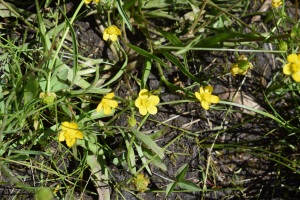
Water Plantain Buttercup

Sierra Lewisia

Camus L

Porterella
Later this July as you walk along the board walk from the Big meadow towards the other meadows notice the small but colorful Porterella flowers growing between trail bric
Tahoe-Yosemite Trail: Genevieve and Crag Lakes
TRAIL DESCRIPTION: Hikers can access the Tahoe-Yosemite Trail (TYT) from the Meeks Bay Trail Head by following Meeks Creek upstream into Desolation Wilderness to Phipps Pass. At about 4.6 miles Genevieve Lake, the first of 7 lakes can be found. Continuing on for another ½ mile hikers are treated to Crag Lake backdropped by the Granitic slopes of Crag Peak standing about 9054 feet. Continuing along the trail hikers will find Hidden Lake, Shadow Lake, Cliff Lake, Stony Ridge Lake and at 8 miles out is Rubicon Lake the 7th and probably the prettiest of all the 7 Tallant Lakes. Round trip to all lakes is about 16 miles.
WINTER SNOWSHOE HIKING: The first part of this trail is great for Cross country skiing and Snowshoe hiking.
Stoney ridge Lake-
This is a great time to visit Stoney Ridge Lake which is about another 1 + miles from Crag Lake. Follow along the East shore of Crag lake through thick forest until you see Hidden and Shadow lakes. Continue up the trail until you reach the North Shore of Stoney Ridge Lake, the largest of the Tallant lakes. There are a number of great campsites on the east shore and the lake makes for excellent swimming!
Suggestion:
Bring bikes and ride the first part of the trail from the parking area (1.2m) to the actual trailhead. This will allow more time to make the hike to Stoney ridge lake.
Look for: One flowered Wintergreen and Sidebells along the forest floor as you near Stoney ridge lake

One flowered Wintergreen

Sidebells
DIRECTIONS: From Tahoe City, take Highway 89 south towards Emerald Bay for about 11 miles. Park on the west side of the road opposite Meeks Bay Campground. From South Shore’s intersection of Highway 50/89 travel north for about 16.5 miles.
The Tallant Lakes lie WITHIN DESOLATION WILDERNESS AND REQUIRE A PERMIT BOTH FOR DAY HIKERS AND CAMPERS. DAYHIKERS MAY SELF-REGISTER AT THE TRAILHEAD. |
In Memory of my buddy Kula

-
Hikes of Tahoe-Truckee
- Mt. Lola
- Rock Creek/Little Lakes Valley
- BAYVIEW TRAIL to AZURE & DICK’S LAKE
- Donner Pass/Sugar Bowl to Squaw Valley
- Mt. Rose
- GRASS, ROCK & JAMISON lakes
- Castle Peak
- BIG MEADOW to DARDANELLES LAKE
- WARD CANYON to PAIGE MEADOWS
- Tahoe-Yosemite Trail: Genevieve and Crag Lakes
- SPOONER LAKE VISTAS & SNOW VALLEY PEAK
- WARD CREEK to TWIN PEAKS and BARKER PASS
- FIVE LAKES
- MARLETTE LAKE/FLUME TRAIL
- ELLIS Lake and ELLIS PEAK
- LAKE OF THE WOODS & Aloha Lake via ECHO LAKES
- SHIRLEY CANYON/SHIRLEY LAKE
- FROG LAKE TO WINNEMUCA LAKE
- SAGEHEN CREEK to Stampede Reservoir
Hiking Areas
Meta






























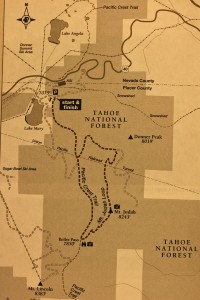














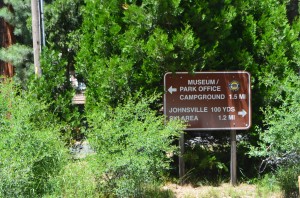



















You must be logged in to post a comment.